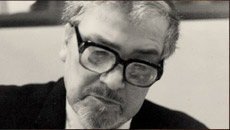William Gibson on The Stars My Destination
I was so young, when I first discovered this book, that I was unable to read it. Which was just as well, as I’d come upon it serialized in a magazine called Galaxy, and had chosen on the basis of covers rather than contents. Starting an incomplete text of The Stars My Destination would have been a disaster.
I’d found it up in the metal loft above the main floor of the Office Supply Store on Main Street, a rickety Erector Set construction of perforated metal, painted battleship gray. There was a particularly pungent corner there, devoted to mouldering pulp, pocket editions a decade old (older than I was, likely) and a few science fiction magazines, similarly ancient. I carried some home in a brown paper bag.
One of them, I discovered, had text with letters going all swirly across the page. Not illustrations, but the actual words in the story turning into pictures. That was Alfred Bester, emulating synesthesia, in the novel you may be lucky enough to be about to read for the first time.
Not that much later, and equipped with a complete text, I was able to read The Stars My Destination (which had been titled Tiger, Tiger in England, and indeed that had been Bester’s title). I’m sure I enjoyed it hugely, but like much of the science fiction I read at the time, it was soon dashed aside by the onrush of puberty and history.
When I happened to rediscover it in my early twenties, I expected little more than a nostalgic read, a glance back to childhood. Instead, it blew, as we used to say, my mind. I hadn’t, I saw, actually been able to read it fully before. It had been too fast for me, too gloriously relentless, too brilliant. I hadn’t been able to appreciate the extent to which Bester strips the dross from classic mechanisms of fiction, because I hadn’t yet known that dross. There hadn’t yet been enough of me to be thrilled by all that the book accomplishes.
It was, I saw in my twenties, a book that had absolutely ignored everything that science fiction had been doing when it was written. It was built on bones pilfered from Dumas and Dickens (steal only the best). It was clad in a skin of archly sophisticated Mad Ave ur-hipness, with all the grot and glitter of a fully happening dude’s postwar Manhattan (something no other science fiction writer of the era was able to offer). It was, I recognized then, an utterly urban thing. It made most of the rest of its assumed genre look hick.
Bester’s protagonist hurls himself naked from a spaceship, fuelled by hatred. Bester’s novel hurled itself naked from the science fiction of its day, fuelled by something hipper than hatred, more potent. Into that vacuum, and on, into the actual 21st Century, Gully and the book rock.
It is, as Bruce Sterling remarked to me on our first meeting, “a seamless pop artifact.” Few and far between, such artifacts; each one a complete anomaly.
Read it. Then find The Demolished Man and read that too.
—Vancouver, February 23, 2012

Alfred Bester

William Gibson on The Stars My Destination
Read Biography
Alfred Bester—My Affair with Science Fiction
Alfred Bester looks back at his career as a writer for science fiction, television, and the comics in this engaging biographical essay from the 1975 collection Hell’s Cartographers.Audio: The Walking Dead:
Bester’s adaptation of “Fondly Fahrenheit” (1954)Other Novels by Alfred Bester






